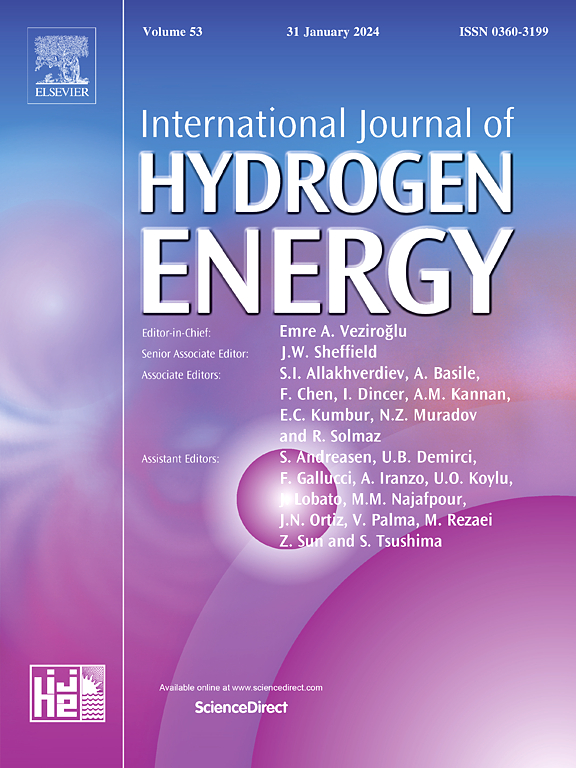Ultra-high efficiency hydrogen production using a large-scale solid oxide electrolysis cell system
IF 8.1
2区 工程技术
Q1 CHEMISTRY, PHYSICAL
引用次数: 0
Abstract
Efficient and cost-effective production of clean hydrogen is key to decarbonizing the production of hard-to-abate industries, such as chemicals, fuels, steel, cement and many other commodities that form the basis of modern societies. High-temperature steam electrolysis (HTSE) has recently become commercially available and offers opportunities for producing hydrogen at higher efficiency and lower cost than competing low temperature technologies. In this work, we report world record setting hydrogen production efficiency from large-scale prototype HTSE systems based on solid oxide electrolysis cell (SOEC) technology. Independent tests performed at Idaho National Laboratory (INL) employed a Bloom Energy 100 kW SOEC system to achieve a hydrogen production direct current specific electric energy consumption as low as 36.7 kWh per kilogram of hydrogen. Remarkably, similar high efficiencies in the range of 36–39 kW/kg-H2 were obtained over a wide range of hydrogen production rates and even during dynamic ramping as the hydrogen production and electric power consumption of the system were varied between 20 % and 100 % of nominal conditions. These test results validate previous projections that commercial SOEC systems can produce clean hydrogen at efficiencies approaching 100 % for less than 2 U S. dollars per kilogram when located near sources of inexpensive, low-grade heat and clean electricity.

大型固体氧化物电解电池系统的超高效率制氢
高效且具有成本效益的清洁氢生产是使化工、燃料、钢铁、水泥和许多其他构成现代社会基础的大宗商品等难以减排的行业脱碳的关键。高温蒸汽电解(HTSE)最近已经商业化,与竞争对手的低温技术相比,它提供了以更高的效率和更低的成本生产氢气的机会。在这项工作中,我们报告了基于固体氧化物电解电池(SOEC)技术的大规模原型HTSE系统的制氢效率创造了世界纪录。在爱达荷国家实验室(INL)进行的独立测试中,Bloom Energy 100 kW SOEC系统实现了制氢的直流比电能消耗低至36.7 kWh / kg氢气。值得注意的是,在很宽的产氢速率范围内,甚至在动态爬坡期间,系统的产氢和电力消耗在20%到100%的标称条件下变化,在36-39 kW/kg-H2范围内获得了类似的高效率。这些测试结果验证了之前的预测,即商业SOEC系统可以在靠近廉价、低品位的热源和清洁电力的情况下,以每公斤不到2美元的成本,以接近100%的效率生产清洁氢气。
本文章由计算机程序翻译,如有差异,请以英文原文为准。
求助全文
约1分钟内获得全文
求助全文
来源期刊

International Journal of Hydrogen Energy
工程技术-环境科学
CiteScore
13.50
自引率
25.00%
发文量
3502
审稿时长
60 days
期刊介绍:
The objective of the International Journal of Hydrogen Energy is to facilitate the exchange of new ideas, technological advancements, and research findings in the field of Hydrogen Energy among scientists and engineers worldwide. This journal showcases original research, both analytical and experimental, covering various aspects of Hydrogen Energy. These include production, storage, transmission, utilization, enabling technologies, environmental impact, economic considerations, and global perspectives on hydrogen and its carriers such as NH3, CH4, alcohols, etc.
The utilization aspect encompasses various methods such as thermochemical (combustion), photochemical, electrochemical (fuel cells), and nuclear conversion of hydrogen, hydrogen isotopes, and hydrogen carriers into thermal, mechanical, and electrical energies. The applications of these energies can be found in transportation (including aerospace), industrial, commercial, and residential sectors.
 求助内容:
求助内容: 应助结果提醒方式:
应助结果提醒方式:


